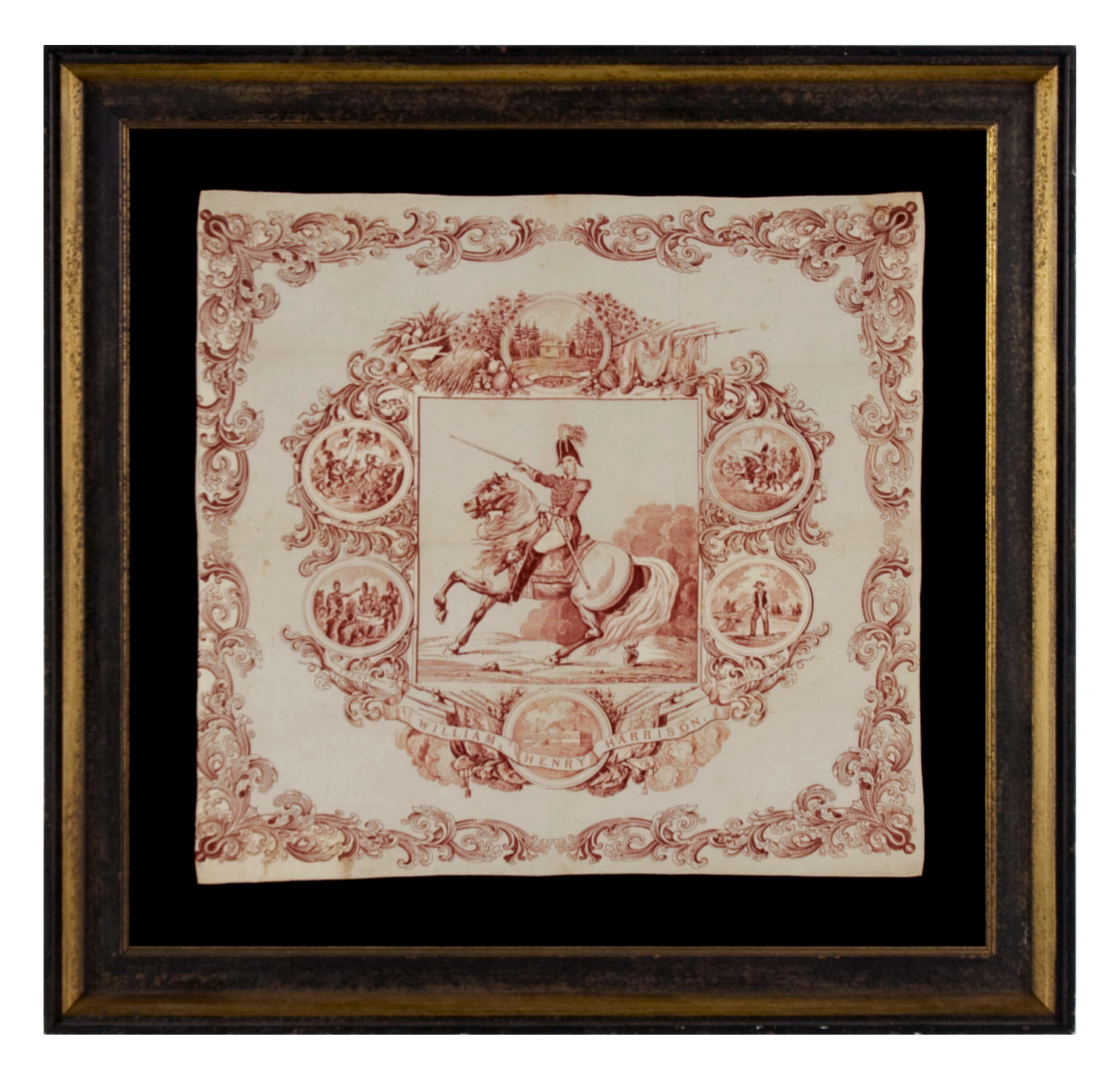


| 1840 CAMPAIGN KERCHIEF FEATURING AN IMAGE OF WILLIAM HENRY HARRISON ON HORSEBACK IN MILITARY GARB, ONE OF THE FIRST KNOWN CAMPAIGN TEXTILES IN EARLY AMERICA |
|
| Web ID: | ker-074 |
| Available: | In Stock |
| Frame Size (H x L): | 37" x 38.25" |
| Flag Size (H x L): | 26" x 27.25" |
| Description: | |
| Printed in mulberry red ink on white cotton, this kerchief's central imagery includes a sweeping portrait of our 9th President, on horseback, in full military garb with sword drawn. Set within a square window, this is framed by a fanciful wreath comprised of six circular medallions, each of which contains a different landscape. Together they paint a picture of Harrison's achievements and campaign identity. Included are his famous 1811 military victory over Shawnee Indian chief Tecumseh and a confederation of various Indian nations at the Battle of Tippecanoe. Harrison adopted this battle as a nickname, with the resulting campaign cry for “Tippecanoe and Tyler too!” Another vignette shows Harrison leading a cavalry charge against Native American at British forces at the War of 1812 Battle of Thames in Canada. Harrison’s victory at Thames was considered pivotal in the war and second only to Andrew Jackson’s triumph at the battle of New Orleans. There are illustrations of a landmark treaty with Northwest Indian Tribes (one of two he facilitated), and of the United States Capital, where Harrison served as both a U.S. Congressman and Senator. Also included are the iconic log cabin and hard cider barrel that became the logos of his campaign, and of Harrison posing as "the Ohio Farmer", plowing fields in North Bend. During the course of the campaign, a Democratic editor dismissed the candidate, stating that if you gave him a $2,000 pension and a barrel of hard cider, he would spend the remainder of his days contented in a Log Cabin. Where one might have seen mud-slinging, the Whigs saw opportunity. Harrison was a member of an aristocratic Virginia family, born on a plantation, who now lived in an expansive Indiana home with 20 rooms and 13 fireplaces. His opponent, Martin Van Buren, was a New Yorker with an aristocratic air, with whom the average man could not connect. The Whigs adopted the disparaging story to create a new identity for their candidate. From here on, the rustic log cabin and hard cider barrel became symbols used to portray Harrison as a commoner. Harrison had recently acquired property in Ohio, where he took a short-lived hand at farming. “The Farmer of North Bend” became another slogan used to mask the reality of Harrison's social circumstances. Harrison was the first presidential candidate to advocate for his own election and the first to employ others to write campaign speeches. His kerchiefs, flags, and banners are the earliest that exist to support a politician who was actively campaigning. Designs are known with imagery or text representing two earlier presidents, Andrew Jackson and John Quincy Adams, but only one example of each may survive and the purpose of their manufacture is unclear. Political supporters and friends may have commissioned their manufacture, but nothing about their origin is presently known. Brief Biography & Notes Regarding the 1840 Campaign William Henry Harrison (b. Feb. 9th, 1773) was the son of wealthy plantation owner Benjamin Harrison V, who was a delegate to the second Continental Congress, a signer of the Declaration of Independence, and Governor of Virginia. William was the last president to be born as a British subject. Following his military career he became secretary of the Northwest Territory, then governor of the subsequently divided Indiana Territory, then moved to Ohio where he served as a U.S. Congressman, State Senator, and U.S. Senator. Martin Van Buren, Harrison’s Democrat opponent, was a New Yorker and the incumbent president. Van Buren's aristocratic air, combined with economic depression that included the devastating collapse of the Second National Bank of the United States, subsequently lost him the 1840 election. At age 68, Harrison was elected as the oldest president to date, inspiring over 80% voter turnout, but today he is best remembered for serving the shortest term in the history of the American presidency. To prove he was not elderly and feeble, he gave a record-breaking hour-and-forty-five minute inauguration speech in freezing rain. Forgetting a topcoat, he then greeted guests and remained outdoors for a prolonged period. He subsequently caught pneumonia and died just 32 days after taking office. Vice President, John Tyler, was chosen for the ticket because he was a Southerner and thus balanced the interests of slave owners. Tyler finished out his 4-year term but was generally unsuccessful in the White House, unpopular, and did not seek reelection. Election Results: William Henry Harrison, Ohio (Whig) - 52.9% PV, 234 EV Martin Van Buren, New York (D) - 46.8% PV, 60 EV Mounting: The kerchief has been hand-stitched to 100% cotton, black in color, which was washed to reduce excess dye. An acid-free agent was added to the wash to further set the dye and the fabric was heat-treated for the same purpose. The mount was then placed in a black-painted, hand-gilded and distressed Italian molding. The glazing is U.V. protective acrylic. Condition: There are minor stains and foxing, but the condition is extraordinary, especially for the period. |
|
| Video: | |
| Collector Level: | Advanced Collectors and the Person with Everything |
| Flag Type: | |
| Star Count: | |
| Earliest Date of Origin: | 1840 |
| Latest Date of Origin: | 1840 |
| State/Affiliation: | Indiana |
| War Association: | 1777-1860 Pre-Civil War |
| Price: | $4,800 |
| E-mail: | info@jeffbridgman.com |
 |
|